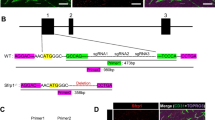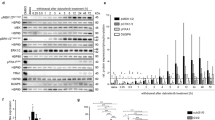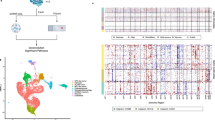Abstract
Glioblastoma is an extremely aggressive and deadly brain tumor known for its striking cellular heterogeneity and capability to communicate with microenvironment components, such as microglia. Microglia-glioblastoma interaction contributes to an increase in tumor invasiveness, and Wnt signaling pathway is one of the main cascades related to tumor progression through changes in cell migration and invasion. However, very little is known about the role of canonical Wnt signaling during microglia-glioblastoma crosstalk. Here, we show for the first time that Wnt3a is one of the factors that regulate interactions between microglia and glioblastoma cells. Wnt3a activates the Wnt/β-catenin signaling of both glioblastoma and microglial cells. Glioblastoma-conditioned medium not only induces nuclear translocation of microglial β-catenin but also increases microglia viability and proliferation as well as Wnt3a, cyclin-D1, and c-myc expression. Moreover, glioblastoma-derived Wnt3a increases microglial ARG-1 and STI1 expression, followed by an upregulation of IL-10 mRNA levels, and a decrease in IL1β gene expression. The presence of Wnt3a in microglia-glioblastoma co-cultures increases the formation of membrane nanotubes accompanied by changes in migration capability. In vivo, tumors formed from Wnt3a-stimulated glioblastoma cells presented greater microglial infiltration and more aggressive characteristics such as growth rate than untreated tumors. Thus, we propose that Wnt3a belongs to the arsenal of factors capable of stimulating the induction of M2-like phenotype on microglial cells, which contributes to the poor prognostic of glioblastoma, reinforcing that Wnt/β-catenin pathway can be a potential therapeutic target to attenuate glioblastoma progression.






Similar content being viewed by others

References
Stupp R, Hegi ME, Gilbert MR, Chakravarti A (2007) Chemoradiotherapy in malignant glioma: standard of care and future directions. J Clin Oncol 25:4127–4136. https://doi.org/10.1200/JCO.2007.11.8554
Louis DN, Ohgaki H, Wiestler OD, Cavenee WK, Burger PC, Jouvet A, Scheithauer BW, Kleihues P (2007) The 2007 WHO classification of tumours of the central nervous system. Acta Neuropathol 114:97–109. https://doi.org/10.1007/s00401-007-0243-4
Friedmann-Morvinski D (2014) Glioblastoma heterogeneity and cancer cell plasticity. Crit Rev Oncog 19:327–336
Albini A, Bruno A, Gallo C, Pajardi G, Noonan DM, Dallaglio K (2015) Cancer stem cells and the tumor microenvironment: interplay in tumor heterogeneity. Connect Tissue Res 56:414–425. https://doi.org/10.3109/03008207.2015.1066780
Balça-Silva J, Matias D, Do Carmo A, Dubois LG, Gonçalves AC, Girão H, Silva Canedo NH, Correia AH et al (2017) Glioblastoma entities express subtle differences in molecular composition and response to treatment. Oncol Rep 38:1341–1352. https://doi.org/10.3892/or.2017.5799
Abou-Antoun TJ, Hale JS, Lathia JD, Dombrowski SM (2017) Brain cancer stem cells in adults and children: cell biology and therapeutic implications. Neurotherapeutics 14:372–384. https://doi.org/10.1007/s13311-017-0524-0
Roos A, Ding Z, Loftus JC, Tran NL (2017) Molecular and microenvironmental determinants of glioma stem-like cell survival and invasion. Front Oncol 7:120. https://doi.org/10.3389/fonc.2017.00120
Garcia C, Dubois LG, Xavier AL, Geraldo LH, da Fonseca ACC, Correia AH, Meirelles F, Ventura G et al (2014) The orthotopic xenotransplant of human glioblastoma successfully recapitulates glioblastoma-microenvironment interactions in a non-immunosuppressed mouse model. BMC Cancer 14:923. https://doi.org/10.1186/1471-2407-14-923
Carvalho da Fonseca AC, Wang H, Fan H, Chen X, Zhang I, Zhang L, Lima FRS, Badie B (2014) Increased expression of stress inducible protein 1 in glioma-associated microglia/macrophages. J Neuroimmunol 274:71–77. https://doi.org/10.1016/j.jneuroim.2014.06.021
Olah M, Raj D, Brouwer N, de Haas AH, Eggen BJL, den Dunnen WFA, Biber KPH, Boddeke HWGM (2012) An optimized protocol for the acute isolation of human microglia from autopsy brain samples. Glia 60:96–111. https://doi.org/10.1002/glia.21251
Razavi S-M, Lee KE, Jin BE, Aujla PS, Gholamin S, Li G (2016) Immune evasion strategies of glioblastoma. Front Surg 3:11. https://doi.org/10.3389/fsurg.2016.00011
da Fonseca ACC, Amaral R, Garcia C et al (2016) Microglia in cancer: for good or for bad? Adv Exp Med Biol 949:245–261. https://doi.org/10.1007/978-3-319-40764-7_12
Audia A, Conroy S, Glass R, Bhat KPL (2017) The impact of the tumor microenvironment on the properties of glioma stem-like cells. Front Oncol 7:143. https://doi.org/10.3389/fonc.2017.00143
Van Meir E, Sawamura Y, Diserens AC et al (1990) Human glioblastoma cells release interleukin 6 in vivo and in vitro. Cancer Res 50:6683–6688
Woiciechowsky C, Asadullah K, Nestler D, Glockner F, Robinson PN, Volk HD, Vogel S, Lanksch WR (1997) Different release of cytokines into the cerebrospinal fluid following surgery for intra- and extra-axial brain tumours. Acta Neurochir 139:619–624
Constam DB, Philipp J, Malipiero UV et al (1992) Differential expression of transforming growth factor-beta 1, -beta 2, and -beta 3 by glioblastoma cells, astrocytes, and microglia. J Immunol 148:1404–1410
Hambardzumyan D, Gutmann DH, Kettenmann H (2016) The role of microglia and macrophages in glioma maintenance and progression. Nat Neurosci 19:20–27. https://doi.org/10.1038/nn.4185
Markovic DS, Glass R, Synowitz M, Rooijen N, Kettenmann H (2005) Microglia stimulate the invasiveness of glioma cells by increasing the activity of metalloprotease-2. J Neuropathol Exp Neurol 64:754–762
Matias D, Predes D, Niemeyer Filho P, Lopes MC, Abreu JG, Lima FRS, Moura Neto V (2017) Microglia-glioblastoma interactions: new role for Wnt signaling. Biochim Biophys Acta 1868:333–340. https://doi.org/10.1016/j.bbcan.2017.05.007
Zhang I, Alizadeh D, Liang J, Zhang L, Gao H, Song Y, Ren H, Ouyang M et al (2016) Characterization of arginase expression in glioma-associated microglia and macrophages. PLoS One 11:e0165118. https://doi.org/10.1371/journal.pone.0165118
Fonseca ACC, da Romão L, Amaral RF et al (2012) Microglial stress inducible protein 1 promotes proliferation and migration in human glioblastoma cells. Neuroscience 200:130–141. https://doi.org/10.1016/j.neuroscience.2011.10.025
Denysenko T, Annovazzi L, Cassoni P et al (2016) WNT/β-catenin signaling pathway and downstream modulators in low- and high-grade glioma. Cancer Genomics Proteomics 13:31–45
Halleskog C, Mulder J, Dahlström J, Mackie K, Hortobágyi T, Tanila H, Kumar Puli L, Färber K et al (2011) WNT signaling in activated microglia is proinflammatory. Glia 59:119–131. https://doi.org/10.1002/glia.21081
Zheng H, Jia L, Liu C-C, Rong Z, Zhong L, Yang L, Chen XF, Fryer JD et al (2017) TREM2 promotes microglial survival by activating Wnt/β-catenin pathway. J Neurosci 37:1772–1784. https://doi.org/10.1523/JNEUROSCI.2459-16.2017
Dijksterhuis JP, Arthofer E, Marinescu VD, Nelander S, Uhlén M, Pontén F, Mulder J, Schulte G (2015) High levels of WNT-5A in human glioma correlate with increased presence of tumor-associated microglia/monocytes. Exp Cell Res 339:280–288. https://doi.org/10.1016/j.yexcr.2015.10.022
Faria J, Romão L, Martins S, Alves T, Mendes FA, de Faria GP, Hollanda R, Takiya C et al (2006) Interactive properties of human glioblastoma cells with brain neurons in culture and neuronal modulation of glial laminin organization. Differentiation 74:562–572. https://doi.org/10.1111/j.1432-0436.2006.00090.x
Kahn SA, Biasoli D, Garcia C et al (2012) Equinatoxin II potentiates temozolomide- and etoposide-induced glioblastoma cell death. Curr Top Med Chem 12:2082–2093
Lima FR, Gervais A, Colin C et al (2001) Regulation of microglial development: a novel role for thyroid hormone. J Neurosci 21:2028–2038
Towbin H, Staehelin T, Gordon J (1992) Electrophoretic transfer of proteins from polyacrylamide gels to nitrocellulose sheets: procedure and some applications. 1979 Biotechnology 24:145–149
Amado NG, Fonseca BF, Cerqueira DM, Neto VM, Abreu JG (2011) Flavonoids: potential Wnt/beta-catenin signaling modulators in cancer. Life Sci 89:545–554. https://doi.org/10.1016/j.lfs.2011.05.003
Oloumi A, Syam S, Dedhar S (2006) Modulation of Wnt3a-mediated nuclear beta-catenin accumulation and activation by integrin-linked kinase in mammalian cells. Oncogene 25:7747–7757. https://doi.org/10.1038/sj.onc.1209752
Liao DJ, Thakur A, Wu J, Biliran H, Sarkar FH (2007) Perspectives on c-Myc, cyclin D1, and their interaction in cancer formation, progression, and response to chemotherapy. Crit Rev Oncog 13:93–158
Clément-Lacroix P, Ai M, Morvan F et al (2005) Lrp5-independent activation of Wnt signaling by lithium chloride increases bone formation and bone mass in mice. Proc Natl Acad Sci U S A 102:17406–17411. https://doi.org/10.1073/pnas.0505259102
Ajmone-Cat MA, D’Urso MC, di Blasio G, Brignone MS, de Simone R, Minghetti L (2016) Glycogen synthase kinase 3 is part of the molecular machinery regulating the adaptive response to LPS stimulation in microglial cells. Brain Behav Immun 55:225–235. https://doi.org/10.1016/j.bbi.2015.11.012
Crain JM, Nikodemova M, Watters JJ (2013) Microglia express distinct M1 and M2 phenotypic markers in the postnatal and adult central nervous system in male and female mice. J Neurosci Res 91:1143–1151. https://doi.org/10.1002/jnr.23242
Dey N, Barwick BG, Moreno CS, Ordanic-Kodani M, Chen Z, Oprea-Ilies G, Tang W, Catzavelos C et al (2013) Wnt signaling in triple negative breast cancer is associated with metastasis. BMC Cancer 13:537. https://doi.org/10.1186/1471-2407-13-537
Yamaguchi H, Condeelis J (2007) Regulation of the actin cytoskeleton in cancer cell migration and invasion. Biochim Biophys Acta 1773:642–652. https://doi.org/10.1016/j.bbamcr.2006.07.001
Shibamoto S, Higano K, Takada R, Ito F, Takeichi M, Takada S (1998) Cytoskeletal reorganization by soluble Wnt-3a protein signalling. Genes Cells 3:659–670
Holmes KC (2009) Structural biology: actin in a twist. Nature 457:389–390. https://doi.org/10.1038/457389a
Kaur N, Chettiar S, Rathod S, Rath P, Muzumdar D, Shaikh ML, Shiras A (2013) Wnt3a mediated activation of Wnt/β-catenin signaling promotes tumor progression in glioblastoma. Mol Cell Neurosci 54:44–57. https://doi.org/10.1016/j.mcn.2013.01.001
Zhang Z-M, Yang Z, Zhang Z (2015) Distribution and characterization of tumor-associated macrophages/microglia in rat C6 glioma. Oncol Lett 10:2442–2446. https://doi.org/10.3892/ol.2015.3533
O’Connor T, Borsig L, Heikenwalder M (2015) CCL2-CCR2 signaling in disease pathogenesis. Endocr Metab Immune Disord Drug Targets 15:105–118
Pontes B, Viana NB, Campanati L, Farina M, Neto VM, Nussenzveig HM (2008) Structure and elastic properties of tunneling nanotubes. Eur Biophys J 37:121–129. https://doi.org/10.1007/s00249-007-0184-9
Hooper C, Sainz-Fuertes R, Lynham S, Hye A, Killick R, Warley A, Bolondi C, Pocock J et al (2012) Wnt3a induces exosome secretion from primary cultured rat microglia. BMC Neurosci 13:144. https://doi.org/10.1186/1471-2202-13-144
Nawaz M, Fatima F (2017) Extracellular vesicles, tunneling nanotubes, and cellular interplay: synergies and missing links. Front Mol Biosci 4:50. https://doi.org/10.3389/fmolb.2017.00050
Acknowledgements
This study was supported by the Brazilian agencies Conselho Nacional de Desenvolvimento Científico e Tecnológico (CNPq), Coordenação de Aperfeiçoamento de Pessoal de Nível Superior (CAPES), Fundação de Amparo à Pesquisa do Estado do Rio de Janeiro (FAPERJ), Pró-Saúde Associação Beneficente de Assistência Social e Hospitalar, and Ary Frauzino Foundation for Cancer Research.
We would like to acknowledge Dra. Juliana Coelho Aguiar for giving us some primers, Dra. Graziella Ventura for helping us with the confocal microscopy acquisitions, and Geralda Cardoso for the lab technical support.
Author information
Authors and Affiliations
Corresponding author
Ethics declarations
Conflict of Interest
We confirm that this manuscript has been approved by all authors and that there are no known conflicts of interest associated with this publication.
Electronic Supplementary Material
ESM 1
(AVI 83542 kb)
Rights and permissions
About this article
Cite this article
Matias, D., Dubois, L.G., Pontes, B. et al. GBM-Derived Wnt3a Induces M2-Like Phenotype in Microglial Cells Through Wnt/β-Catenin Signaling. Mol Neurobiol 56, 1517–1530 (2019). https://doi.org/10.1007/s12035-018-1150-5
Received:
Accepted:
Published:
Issue Date:
DOI: https://doi.org/10.1007/s12035-018-1150-5



